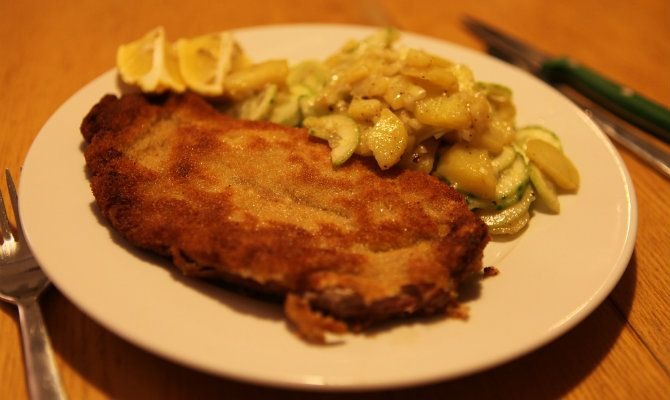What You Need To Know About Austrian Wiener Schnitzel
If travel is all about discoveries, good and bad, high and low, a trip to Austria and a lesson on wiener schnitzel probably covers all four of those at once. First of all, who doesn't remember that line in The Sound of Music, in the song "My Favorite Things," that cites "Cream-colored ponies and crisp apple strudel, doorbells and sleigh bells and schnitzel with noodles"? Wiener schnitzel, any Viennese cook will tell you, is never served with noodles. That's lesson number one.
Lesson No. 2 is to never confuse wiener schnitzel with hot dogs or sausages of any kind. Wiener translates to "Viennese," as in Vienna, for which the dish is named. The rest of Austria then adopted it as its national dish.
Lesson No. 3 is to never mess with anyone's national dish. Despite obvious similarities, Viennese schnitzel must never be mistaken for a recipe from any other country, the most obvious of these being cotoletta alla Milanese, which is similarly breaded and fried right next door in Italy. Until fairly recently, legend had it that an Austrian field marshal named Radetzky von Radetz had brought the recipe back from Italy to Vienna in 1857. An adjutant to the Emperor Franz Joseph had sampled a veal steak in Lombardy, and Redetsky was supposedly called upon to retrieve its recipe.
In 1972, a food historian named Heinz-Dieter Pohl debunked the entire written history of the dish. Apparently, associating the national dish of Austria with anywhere but Austria is verboten, and Pohl went after it with a vengeance. He suggested that there were other dishes in Austrian cuisine that were similarly breaded and deep-fried, including the popular, if unfortunately named, backhendl (fried chicken), which was first mentioned in a 1719 cookbook — long before Redetsky's foray into Lombardy. So there!
Lesson No. 4: Any trip to Austria must include this marvelous dish. But a great wiener schnitzel is deceptively simple. At its best, the meat is so tender, it can be cut with a fork. The breading must be crispy but never greasy. A squirt of lemon is essential for the zing of the dish. The trick is in the technique. The veal cutlet — and in Vienna it is always veal — must be very thin, the flour coating light, the eggs beaten, and the breadcrumbs applied with a light hand. But most importantly, when it's cooked, the schnitzel must swim in hot fat. That fat must be lard or clarified butter or duck or goose fat. Forget using oil of any kind. Once you've got the rules down, wiener schnitzel is one of the easiest things you'll ever cook.
And here is the authentic recipe from the Austrian Tourism Board:
Recipe for wiener schnitzel. Serves 4. Takes all of 15 minutes to make.
Ingredients:
4 veal cutlets, 5–6 ounces each
2 eggs
Approximately 4 ounces flour
Approximately 4 ounces breadcrumbs
Salt and pepper
Clarified butter or lard, duck, or goose fat
Slices of lemon, to garnish
Lay out the schnitzel, remove any skin, and beat until thin. Season on both sides with salt and pepper. Place flour and breadcrumbs onto separate flat plates; beat the eggs together in a bowl using a fork.
Coat each schnitzel on both sides in flour, then dredge through the beaten eggs, ensuring that no part of the schnitzel remains dry. Lastly, coat in the breadcrumbs and carefully press down the crumbs using the reverse side of the fork (this causes the crumb coating to "fluff up" better during cooking).
In a large pan (or 2 medium-sized pans), melt enough clarified butter or fat for the schnitzel to be able to swim freely in the oil.
Only place the schnitzel in the pan when the fat is so hot that it hisses and bubbles up if some breadcrumbs or a small piece of butter is introduced to it.
Depending on the thickness and the type of meat, fry for between 2 minutes and 4 minutes until golden brown. Turn using a spatula (do not pierce the coating!) and fry on the other side until similarly golden brown.
Remove the crispy schnitzel and place on a paper towel to dry off. Dab carefully to dry the schnitzel. Arrange on the plate and garnish with slices of lemon before serving.
Serve with parsley potatoes, rice, potato salad, or mixed salad.
